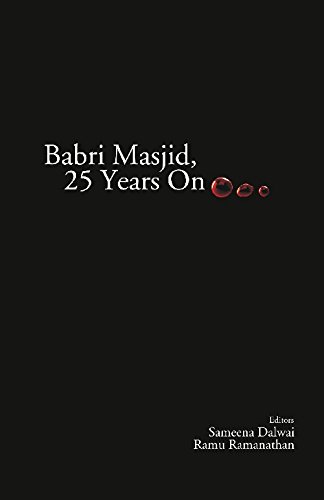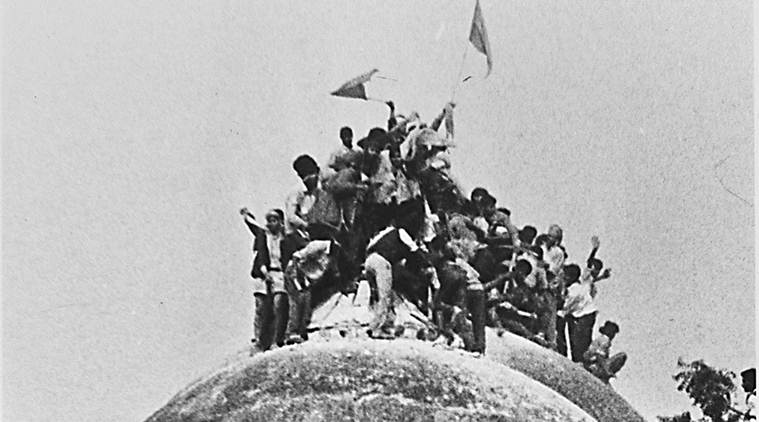Babri Masjid: 25 Years On was published as a Special Issue by the Indian Journal of Secularism in 2017 to commemorate 25 years of the demolition of the Babri Masjid. The book has multiple narratives — eye-witness accounts, essays on the political events that led upto the demolition, the riots that followed, and how different sections of soceity were affected by it, how they reacted, how they dealt with it. The book has been edited by Sameena Dalwai and Ramu Ramanathan. The following extract is from the chapter “Countdown to Ayodhya” by Anant Bagaitkar.

Pre-demolition
The year was 1992 and the month was July. It was autumn. Monsoon session of the Parliament was on. The PV Narasimha Rao-Congress government was grappling with the Ayodhya issue. The Vishwa Hindu Parishad (VHP), Rashtriya Swayamsevak Sangh (RSS) and all the other linked Hindu organisations had made a declaration for the kar seva (offering service for a religious cause) at the disputed site at Ayodhya – a 2.7-acre plot where the Ram idol was supposedly standing and where the Babri Masjid actually stood.
The Rao government appealed to the VHP, RSS and other allied Hindu organisations to not precipitate the matter. These organisations did not take any call, instead tossed the government towards the Hindu saints who were planning the kar seva. Finally, the Rao government had a dialogue with the saints and a decision was made to allow ‘symbolic kar seva’. The saints gave a three-month deadline to the government to resolve the vexed issue. Everybody knew arriving at a solution in three months was next to impossible. Thus, the extension given to the government was nothing but postponement of death by another day. Obviously, journalists were always on the lookout for exclusive news and information. And I wasn’t an exception.
During those days, a senior RSS functionary was coordinating action plans and agitations of the various organisations involved in the issue. He used to be elusive. Many attempts to meet him were rendered futile. But one day luck arrived knocking on the door.
A senior BJP leader met me in the Parliament Library. He whispered to me. He had just returned from a meeting with this elusive leader and knew his whereabouts. If I wanted to meet him I should simply go but not disclose his name. I started planning. I had no vehicle. I contacted a friend who was then working with Navbharat Times. I requested him for his car. Four of us, journalists from different newspapers, ventured out in search of the latest updates on the issue.
[…]
… We came out, sat in the car and headed for the Parliament. We were still unable to come to terms with what the old man had told us. But our purpose was served. We were undeniably sure in our minds that something terrible was going to happen in this country and that the days of the Babri Masjid are numbered. The countdown had begun. And we had sensed it.
…
The year was 1992. It was September. VHP leaders VH Dalmiya and Ashok Singhal declared that a temple cannot be constructed without the demolition of the Babri Masjid.
…
The year was 1992. October. VHP organised a meeting of the dharma sansad to consider the future course of action on the issue. In this meeting the decision was taken to resume the kar seva and the date decided was 6 December,1992. October onwards the scheme began take shape. The chief minister of Uttar Pradesh, Kalyan Singh (from BJP), made calculative moves to dodge the Government of India. The Union government had asked for the receivership of the disputed land which the Supreme Court had declined in view of the undertaking given by the Uttar Pradesh government of Kalyan Singh that the kar seva will be performed in accordance with court orders.
Then the Union government had sanctioned Central Paramilitary Forces (CPMFs) for the protection of the structure, which was protested and refused by Kalyan Singh.RSS, in a statement, made it clear that they were not interested in a ‘symbolic kar seva’ as it will not serve any purpose; a purpose only they knew of.
…
The year was 1992. November. A very significant statement made by a VHP leader, Champat Rai, arrived in the last week of November. It said, “This time we will adopt guerrilla tactics for performing kar seva.”
By November end RSS, VHP, Bajrang Dal and Shiv Sena workers gathered in Ayodhya as kar sevaks. Even before 6 December, the assembled mob indulged in attacking mosques and mazars (shrines) in the vicinity of Ayodhya.
…

The year was 1992. And it was Sunday, 6 December. Babri Masjid was attacked and demolished. What we had heard from the old man had come true.
…
It is 2017. 25 years have passed.
…
Post-demolition
I recall a reaction expressed by an ardent and devoted RSS worker.One day, post the demolition, the Ayodhya issue came up for discussionat the dinner table. He said, “Yes, 99 per cent of Hindus wanted Ram Mandir to be built in Ayodhya, but 99% of those 99% Hindus were definitely of the view that it should NOT follow the demolition of a masjid.”
[The demolition] came as a severe shock to the Rao government. The government was dumbfounded. Till the evening of the day of demolition there was no reaction from the government. But the then President of India, Dr Shankar Dayal Sharma, was the first to come out with a statement condemning the demolition. According to the information that trickled out of Rashtrapati Bhavan, Dr Sharma was in tears after hearing the news. He was unable to control his emotions and he came out with a statement against this act. The President issuing a statement was not as per the conventions. In the Indian scheme of governance, the President enjoys little authority. Thus, the President’s statement came as a surprise. He “strongly deplored vandalism that caused damage to the masjid in Ayodhya” and had observed, that, “such acts go against the (philosophy of) Hinduism.” Dr Sharma played the role of the First Citizen of the nation. Many observers felt that the statement was harsh. Then followed other statements. Vice president K R Narayanan described it as the “biggest tragedy only next to the assassination of Mahatma Gandhi.” Former Prime Minister V P Singh said, “They were not three domes of the mosque, they were the three pillars of the State of India: Legislature, Judiciary and Executive.”
Hours after the incident, slowly the slumbered ruling party, the Congress, started coming to its senses. There were a few noises of the so-called rebellion. But by evening, Rao and his supporters in the Congress party managed to gather support in the hour of a crisis of the gravest nature. They were successful in convincing detractors that the time was not for a rebellion but to come to the aid of the party.There were flurry of political activities. As per an insider, some Congress leaders started visiting Rao at his official residence, 7 Race Course Road (7-RCR), and started [questioning his inaction].
Some demanded home minister SB Chavan be sacked, one MP from Uttar Pradesh even verbally abused Chavan. Arjun Singh (from Congress party) and few others spoke against the leadership. According to the eyewitnesses, Rao was completely shaken and silent. There was a stream of party colleagues and ministers and everybody had [the same questions].
“We had said so, this would happen”.
“Why no necessary precautions were taken?”
“Why was the Kalyan Singh government in Uttar Pradesh not dismissed as a precautionary measure?”
In the evening there was an emergency cabinet meeting after which Rao went on-air and explained to the nation how the demolition took place and how a conspiracy was hatched for it. Four BJP state governments were dismissed with immediate effect and the President’s Rule was imposed. In all the communally sensitive cities across the country, the Indian Army was put on high alert.
Next day, as per the plan, [a Congress Parliamentary Party (CPP)] meeting was convened. There were murmurs heard around that some members will raise the demand for the resignation of the prime minister. But by then Rao and his supporters were in full command of the situation. Some members wanted to speak in the meeting but knowing the danger Muttemwar drew the members’ attention to the convention that in a CPP meeting only the secretary and the leader can speak and others are not allowed to speak. Muttemwar, an impressive orator started his speech with Allama Iqbal’s couplet –
Kuch baat hai ki hasti mit-ti nahi hamari
Sadiyon raha hai dushman daur-e-zaman hamara
(There must be something special that we still exist despite the whole world against us).
… Rao then spoke and explained the circumstances leading to the demolition and how it was necessary for everybody to stay united. …
The Parliament was in session. Except Atal Bihari Vajpayee and Jaswant Singh, the top brass BJP leaders were arrested. LK Advani offered to resign from the Parliamentary Party leadership, taking moral responsibility of the demolition. He claimed he was not in favour of the demolition. When the Parliament assembled the next working day, all eyes were on the BJP leadership. Vajpayee, his usual calm demeanour, entered the Lok Sabha. He encountered acrimonious and completely unfriendly stares from the non-BJP party members. It was a surreal atmosphere. And the spectre of that surrealism descended upon the Lok Sabha. The attack from non-BJP parties was obvious and expected. Normal business was suspended and the discussion on the demolition was taken up.
Vajpayee, without mincing words, expressed regret about the demolition. The debate proceeded with the thrashing of the thread of BJP-RSS-Sangh Parivar. But at the same time appeals were being made to sections of society to maintain calm. At this time, a unique scene was witnessed. BJP, the main opposition party was guilty of the demolition and the ruling party Congress was equally guilty of allowing it to happen. Speakers from both the parties were apologetic. Arjun Singh of Congress party who was vehement in his statements could not stir up the Congress MPs to rise to the occasion…
After the Parliament debate on the issue, [the] government started functioning in a normal way. Mumbai and other cities had started reacting to the act of demolition. For the next few days, the government was in firefighting mode. Strangely, … the then spokesperson of BJP, Sunder Singh Bhandari blamed Shiv Sena for the demolition.
Why Ayodhya?
It was at the BJP National Executive meeting held at Palampur in Himachal Pradesh from 9 to 11 June, 1989, where the party officially decided to support the issue of Ayodhya being the birthplace of Lord Ram and the temple should be built there as per the faith of Hindus. This stand taken by the BJP paid rich dividends and in the ensuing Lok Sabha elections, for the first time, the party was able to win 85 seats. It realised the potential of the Ram Mandir issue. After 6 December, there was no turning back. BJP, and especially the leadership of the party driven by RSS, was convinced that this is the issue on which they can rise to power. A religious and highly emotive issue was taken up merely for political and electoral gains. Because it cuts across the caste spectrum, overshadows the caste politics in India and establishes the politics based on a particular religion. … BJP, which had tried its best in the past to polarise voters on religious count, wasn’t very successful. Their attempts failed due to the politics of caste. … In 1989 Lok Sabha elections, BJP succeeded in shifting the focus from caste to religion.The calculation was simple. Once the supremacy of religion is established, caste considerations will become secondary. …This is true and applicable even today!




